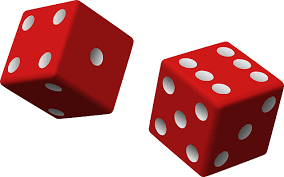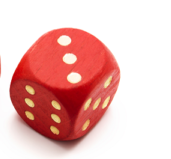Science > Mathematics > Statistics and Probability > Probability > Sample Space of an Experiment
In the last article, we have studied the concept of probability. In this article, we shall study to write a sample space for a given event.

The Sample Space for Random Experiments:
From a group of 2 boys and 3 girls, two children are selected at random.
Two children out of the total 5 can be selected by 5C2 ways = 10 ways
Let the two boys are B1 and B2 and the three girls are G1, G2, and G3. The sample space is
S = { B1B2, B1G1, B1G2, B1G3, B2G1, B2G2, B2G3, G1G2, G1G3, G2G3}
n(S) = 10
A coin is tossed. If it shows head, we draw a ball from a bag consisting of 3 red and 4 black balls; if it shows a tail, we throw a die.
Let the three red balls are R1, R2, and R3 and four black balls are B1, B2, B3, and B4. The sample space is
S = { (H, R1), (H, R2), (H, R3), (H, B1), (H, B2), (H, B3), (H, B4), (T, 1), (T, 2), (T, 3), (T, 4), (T, 5), (T, 6)}
n(S) = 13
An experiment consists of rolling a die and tossing a coin once if the number on the die is even, If the number on the die is odd, the coin is tossed twice.
The sample space is
S = { (2, H), (2, T), (4, H), (4, T), (6, H), (6, T), (1, HH), (1, HT), (1, TH), (1, TT),
3, HH), (3, HT), (3, TH), (3, TT), (5, HH), (5, HT), (5, TH), (5, TT)}
n(S) = 18
A coin is tossed four times
The sample space is
S = { HHHH, HHHT, HTHH, THHH, HHTH, HHTT, HTTH, TTHH,
THHT, HTHT, THTH, TTTH, TTHT, THTT, HTTT, TTTT}
n(S) = 16
A coin is tossed and dice is thrown.
The sample space is
S = { (H, 1), (H, 2), (H, 3), (H, 4), (H, 5), (H, 6), (T, 1), (T, 2), (T, 3), (T, 4), (T, 5), (T, 6)}
n(S) = 12
A coin is tossed and dice is rolled only in case the head is shown on the coin.
The sample space is
S = { T, (H, 1), (H, 2), (H, 3), (H, 4), (H, 5), (H, 6)}
n(S) = 7
A coin is tossed twice and dice is rolled only in case the second throw is tail.
The sample space is
S = { HH, TH, (HT, 1), (HT, 2), (HT, 3), (HT, 4), (HT, 5), (HT, 6),
(TT, 1), (TT, 2), (TT, 3), (TT, 4), (TT, 5), (TT, 6)}
n(S) = 14
The experiment is of tossing a coin and tossing it for the second time if the head occurs. If the tail occurs on the first toss, then the die is tossed once.
The sample space is
S = { (H, H), (H, T), (T, 1), (T, 2), (T, 3), (T, 4), (T, 5), (T, 6)}
n(S) = 8
A coin is tossed. If it shows a tail, we draw a ball from a box which contains 2 red and 3 black balls; if it shows head, we throw a die.
Let the two red balls are R1 and R2 and three balls are B1, B2 and B3. The sample space is
S = { (T, R1), (T, R2), (T, B1), (T, B2), (T, B3), (H, 1), (H, 2), (H, 3), (H, 4), (H, 5), (H, 6)}
n(S) = 11
A coin is tossed repeatedly until a tail comes for the first time.
The sample space is
S = {T, HT, HHT, HHHT, HHHHT, ………..}
n(S) = ∞
A box contains 1 red and 3 black balls; Two balls are drawn at random in succession without replacement.
Let the one red ball be R1 and three balls are B1, B2 and B3. The sample space is
S = { (R1, B1), (R1, B2), (R1, B3), (B1, R1), (B1, B2), (B1, B3) , (B2, B1), (B2, B3), (B3, B1), (B3, B2),}
n(S) = 10
A pair of dice is rolled. If the outcome is a doublet, a coin is tossed. Determine the total number of elementary events associated with this experiment.
The sample space is
S = {(1, 2), (1, 3), (1, 4), (1, 5), (1, 6), (2, 1), (2. 3), (2, 4),
(2, 5). (2, 6), (3, 1), (3, 2), (3, 4), (3, 5), (3, 6), (4, 1),
(4, 2), (4, 3), (4, 5), (4, 6), (5, 1), (5, 2), (5, 3), (5, 4),
(5, 6), (6, 1I), (6, 2), (6, 3). (6, 4), (6, 5), (1, 1, H), (1, 1, T),
(2, 2, H), (2, 2, T), (3, 3, H), (3, 3, T), (4, 4, H), (4, 4, T),
(5, 5, H), (5, 5, T), (6, 6, H), (6, 6, T) }
n(S) = 42
A coin is tossed twice. If the second draw results in a head, a die is rolled.
The sample space is
S = { TT, HT, (HH, 1), (HH, 2), (HH, 3), (HH, 4), (HH, 5), (HH, 6), (TH, 1), (TH, 2), (TH, 3), (TH, 4), (TH, 5), (TH, 6),}
n(S) = 14
A bag contains 4 identical red balls and 3 identical black balls. The experiment consists of drawing a ball from the bag and replacing back in the box; then again drawing a ball.
The sample space is S = { RR, RB, BR, BB}
n(S) = 4
Note: As balls are identical no suffixes are used.
In random sampling, three items are selected from a lot. Each item is tested and classified as defective (D) or non-defective (N).
The sample space is
S = { DDD, DDN, DND, NDD, DNN, NDN, NND, TTT}
n(S) = 8
An experiment consists of boy girl composition of families with two children. We are interested in knowing whether it is a boy or a girl in the order of their birthdays.
The sample space is
S = { (B1, B2), (B1, G2), (G1, B2), (G1, G2)}
n(S) = 4
An experiment consists of a boy-girl composition of families with two children. We are interested in the number of boys in the family.
The sample space is
S = { 0, 1, 2}
n(S) = 3
There are three coloured dice of red, white and black colour. These dice are placed in a bag. One is drawn at random and rolled its colour and the number on the uppermost face is noted.
The sample space is
S = { (R, 1), (R, 2), (R, 3), (R, 4), (R, 5), (R, 6), (W, 1), (W, 2), (W, 3),
(W, 4), (W, 5), (W, 6), (B, 1), (B, 2), (B, 3), (B, 4), (B, 5), (B, 6)}
n(S) = 18
2 boys and 2 girls are in room P and 1 boy and three girls are in room Q. A person is selected from one of the rooms.
Let the two boys in the room P be B1, B2 and that in the room Q be B3.
Let the two girls in the room P be G1, G2 and those in the room Q be G3, G4 and G5.
The sample space is
S = { (P, B1), (P, B2), (P, G1), (P, G2), (Q, B3), (Q, G3), (Q, G4), (Q, G5)}
n(S) = 8
A bag contains one white and one red ball. A ball is drawn from the bag. If ball drawn is white is replaced back in the bag and again a ball is drawn from the bag; otherwise, a die is rolled.
The sample space is
S = { WW, WR, (R, 1), (R, 2), (R, 3), (R, 4), (R, 5), (R, 6)}
n(S) = 8
A bag contains 1 white and 3 identical black balls. Two balls are drawn at random from the bag in succession.
The sample space is
S = { WB, BW, BB}
n(S) = 3
The numbers 1, 2, 3 and 4 are written separately on four slips of paper. The slips are then put in a box and mixed thoroughly. A person draws two slips from a box, one after the other, without replacement.
The sample space is
S = { (1, 2), (1, 3), (1, 4), (2, 1), (2, 3), (2, 4), (3, 1), (3, 2), (3, 4), (4, 1), (4,2), (4,3)}
n(S) = 12
A coin is tossed. If the result is head, a die is thrown. If the die shows an even number, the die is thrown again.
The sample space is
S = { T, (H, 1), (H, 3), (H, 5), (H, 2, 1), (H, 2, 2), (H, 2, 3), (H, 2, 4),
(H, 2, 5), (H, 2, 6), (H,4, 1), (H, 4, 2), (H, 4, 3), (H, 4, 4),
(H, 4, 5), (H, 4, 6), (H, 6, 1), (H, 6, 2), (H, 6, 3),
(H, 6, 4), (H, 6, 5), (H, 6, 6),}
n(S) = 22
In the next article, we shall study the meaning of events and their types and also to write event space for the given experiment.
